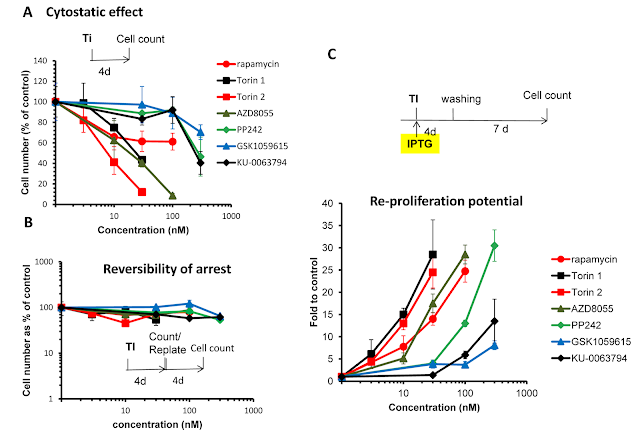Pan-mTOR inhibitors may be superior to rapamycin for antiaging
by noreply@blogger.com (brian wang) from NextBigFuture.com on (#2990F)
Gerosuppression by pan-mTOR inhibitors
Rapamycin slows organismal aging and delays age-related diseases, extending lifespan in numerous species. In cells, rapamycin and other rapalogs such as everolimus suppress geroconversion from quiescence to senescence. Rapamycin inhibits some, but not all, activities of mTOR. Recently we and others demonstrated that pan-mTOR inhibitors, known also as dual mTORC1/C2 inhibitors, suppress senescent phenotype. As a continuation of these studies, here we investigated in detail a panel of pan-mTOR inhibitors, to determine their optimal gerosuppressive concentrations. During geroconversion, cells become hypertrophic and flat, accumulate lysosomes (SA-beta-Gal staining) and lipids (Oil Red staining) and lose their re-proliferative potential (RPP). We determined optimal gerosuppressive concentrations: Torin1 (30 nM), Torin 2 (30 nM), AZD8055 (100 nM), PP242 (300 nM), both KU-006379 and GSK1059615 (1000 nM). These agents decreased senescence-associated hypertrophy with IC50s: 20, 18, 15, 200 and 400 nM, respectively. Preservation of RPP by pan-mTOR inhibitors was associated with inhibition of the pS6K/pS6 axis. Inhibition of rapamycin-insensitive functions of mTOR further contributed to anti-hypertrophic and cytostatic effects. Torin 1 and PP242 were more "rapamycin-like" than Torin 2 and AZD8055. Pan-mTOR inhibitors were superior to rapamycin in suppressing hypertrophy, senescent morphology, Oil Red O staining and in increasing so-called "chronological life span (CLS)". We suggest that, at doses lower than anti-cancer concentrations, pan-mTOR inhibitors can be developed as anti-aging drugs.
Rapamycin slows down aging in yeast, Drosophila, worm and mice. It also delays age-related diseases in a variety of species including humans. Numerous studies have demonstrated life extension by rapamycin in rodent models of human diseases. The maximal lifespan extension is dose-dependent. One explanation is trivial: the higher the doses, the stronger inhibition of mTOR. There is another explanation: mTOR complex 1 (mTORC1) has different affinity for its substrates. For example, inhibition of phosphorylation of S6K is achieved at low concentrations of rapamycin, whereas phosphorylation of 4EBP1 at T37 / 46 sites is insensitive to pharmacological concentrations of rapamycin. Unlike rapalogs, ATP-competitive kinase inhibitors, also known as dual mTORC1/C2 or pan-mTOR inhibitors, directly inhibit the mTOR kinase in both mTORC1 and mTORC2 complexes

Read more










Rapamycin slows organismal aging and delays age-related diseases, extending lifespan in numerous species. In cells, rapamycin and other rapalogs such as everolimus suppress geroconversion from quiescence to senescence. Rapamycin inhibits some, but not all, activities of mTOR. Recently we and others demonstrated that pan-mTOR inhibitors, known also as dual mTORC1/C2 inhibitors, suppress senescent phenotype. As a continuation of these studies, here we investigated in detail a panel of pan-mTOR inhibitors, to determine their optimal gerosuppressive concentrations. During geroconversion, cells become hypertrophic and flat, accumulate lysosomes (SA-beta-Gal staining) and lipids (Oil Red staining) and lose their re-proliferative potential (RPP). We determined optimal gerosuppressive concentrations: Torin1 (30 nM), Torin 2 (30 nM), AZD8055 (100 nM), PP242 (300 nM), both KU-006379 and GSK1059615 (1000 nM). These agents decreased senescence-associated hypertrophy with IC50s: 20, 18, 15, 200 and 400 nM, respectively. Preservation of RPP by pan-mTOR inhibitors was associated with inhibition of the pS6K/pS6 axis. Inhibition of rapamycin-insensitive functions of mTOR further contributed to anti-hypertrophic and cytostatic effects. Torin 1 and PP242 were more "rapamycin-like" than Torin 2 and AZD8055. Pan-mTOR inhibitors were superior to rapamycin in suppressing hypertrophy, senescent morphology, Oil Red O staining and in increasing so-called "chronological life span (CLS)". We suggest that, at doses lower than anti-cancer concentrations, pan-mTOR inhibitors can be developed as anti-aging drugs.
Rapamycin slows down aging in yeast, Drosophila, worm and mice. It also delays age-related diseases in a variety of species including humans. Numerous studies have demonstrated life extension by rapamycin in rodent models of human diseases. The maximal lifespan extension is dose-dependent. One explanation is trivial: the higher the doses, the stronger inhibition of mTOR. There is another explanation: mTOR complex 1 (mTORC1) has different affinity for its substrates. For example, inhibition of phosphorylation of S6K is achieved at low concentrations of rapamycin, whereas phosphorylation of 4EBP1 at T37 / 46 sites is insensitive to pharmacological concentrations of rapamycin. Unlike rapalogs, ATP-competitive kinase inhibitors, also known as dual mTORC1/C2 or pan-mTOR inhibitors, directly inhibit the mTOR kinase in both mTORC1 and mTORC2 complexes

Read more